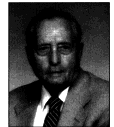Homer R. (Barney) Oldfield
Born August 28, 1916, Mount Vernon, N. Y; as manager of General Electric's Computer Department, put the company into position to become a significant player in the computer business; later, as president of Searle Medidata, introduced the first computerized medical-history taker and associated on-line automated multiphasic health testing system.

Education: BS, aeronautical engineering, MIT, 1938; MS, instrumentation, MIT, 1939.
Professional Experience: research associate, MIT Instrument Laboratory, 1939-1941; US Army, Coast Artillery Board, Project Officer, Microwave Radar 1941-1943; US Army Air Force, 1943-1945; visiting professor, Cornell University, 1951-1952; General Electric Company: Air Force Sales, Gov't. Division, Syracuse, 1945-1948; manager of sales, Gov't. Division, 1948-1949; operations manager, GE Advanced Electronics Center, Cornell University, 1950-1952; director, GE Microwave Laboratory, Stanford, Calif., 1952-1955; general manager, Computer Department, Phoenix, Ariz., 1955-1958; Raytheon: general manager, Equipment Division, Wayland, Mass., 1959-1960; senior vice president, Electronic Components (including two years as general manager, Raytheon Europe, Rome), 1960-1964; DASA Corp., Andover, Mass: general manager and vice president, Data Communications Systems, 1964-1968; G.D. Searle: president, Searle Medidata, Lexington, Mass. (Hospital Information Systems and Multiphasic Health Testing Systems), 1968-1974; Medidata Health Services, Rockville, Md.: part owner and senior vice president, 1975-1989, Far East representative, Kailua-Kona, Hawaii, 1989-1991; semiretired and consultant, 1991-2000; free-lance writer, 1989-2000.
Honors and Awards: Legion of Merit with Palms; Commendation Ribbon; European Theater Medal with Star; fellow, Institute of Radio Engineers; fellow, International Health Evaluation Association; member, American Medical Informatics Association.
While with the General Electric Company, Oldfield founded two research and development laboratories in association with two major universities. One was the GE Advanced Electronics Center at Cornell University, devoted to radar, countermeasures, and communications R&D for the US government; the second was the General Electric Microwave Laboratory at Stanford, which developed microwave tubes and associated microwave devices. These two laboratories were among the first to establish close industry-university relationships.
Also, with General Electric, Oldfield formed a team including GE, Stanford Research Institute, and the Bank of America to produce the ERMA [Electronic Recording Machine Accounting] system for automating the checking account bookkeeping process. The ERMA computer was one of industry's first transistorized computers. The data entry technique of magnetic ink character reading (MICR) direct from checks became the worldwide standard, still in use today after almost 35 years.
Later, as president of Searle Medidata, Inc., a subsidiary of G.D. Searle & Co. (pharmaceuticals), he organized a team of engineers, programmers, biochemists, physicians, and paramedicals to develop a line of computer-based systems for the medical profession. Several of the systems utilizing DEC's PDP-8I and PDP-11, installed in the mid-1970s, were still in active use a quarter of a century later. During this period, he organized the International Health Evaluation Association, which continues to bring together preventive medicine experts from all over the world, and is active in promoting computerized health evaluation techniques.
QUOTATION
"Invented in 1819, the stethoscope was not accepted by physicians for half a century. The computer takes a little longer, but its day will come. "
BIBLIOGRAPHY
Biographical
McKenney, James, and Amy Fisher, "The Manufacture of the ERMA," Ann. Hist. Comp., Vol. 15, No. 4, 1993.
UPDATES
Homer Oldfield died June 22, 2000. (THVV, 2023)
New content Copyright © 2013-2023 by the IEEE Computer Society and the Institute of Electrical and Electronics Engineers Inc.
All rights reserved. This material may not be reproduced or redistributed without the express written permission of the copyright holder.
